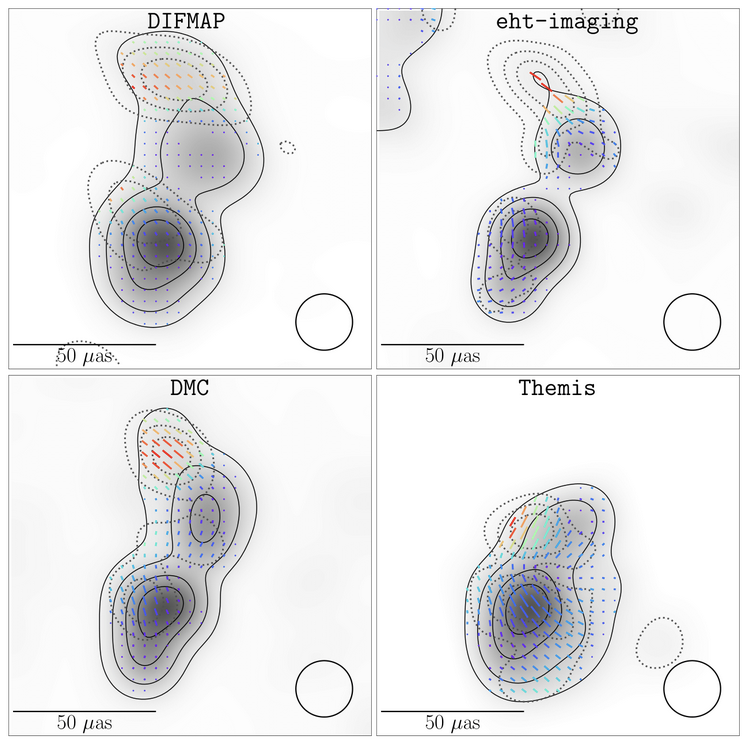A global collaboration of scientists used the Earth-size virtual radio telescope, the Event Horizon Telescope (EHT), to see the innermost parts of the quasar NRAO 530. Quasars are extremely powerful sources of radiation located in the centers of distant galaxies. Their central engines are supermassive black holes, funneling accelerated particles and radiation into bright thin jets. Astronomers are trying to understand the complicated physics of these cosmic monsters, struggling with questions like how exactly are the jets powered and created, and what is the role of magnetic fields in their formation. The EHT offers extremely high, unprecedented angular resolution, allowing astronomers to image the previously unseen structures in the very central region of NRAO 530.
The EHT collaboration uses different imaging algorithms to gain confidence about the structure of an object on fine scales that are opaque at longer wavelengths. These include new methods developed explicitly for high frequency Very Long Baseline Interferometry (VLBI) imaging, eht-imaging, SMILI, DMC, and Themis, and the traditional VLBI method CLEAN. All of them were employed for obtaining the first image of the black hole shadow in the active galaxy M87 (EHT collaboration, 2019). The EHT allows scientists to investigate the magnetic field structure in the vicinity of the black hole and innermost part of the jet through observations of polarized light behavior. The figure shows images of the quasar NRAO 530 obtained by different methods in total and polarized light, which are presented in a new paper by Jorstad, Wielgus et al. 2023.
The images reveal a bright feature located on the southern end of the jet, which the authors associate with the VLBI core at millimeter wavelengths. In quasars similar to NRAO 530 the core manifests the place where the jet starts at a given wavelength. The core has a sub-structure consisting of two components, which is impossible to resolve at longer wavelengths. The jet extends over the distance that light crosses in ~1.7 years in projection on the sky plane and possesses two features with orthogonal directions of polarization (electric vector position angle, EVPA), parallel and perpendicular to the jet direction. The authors interpreted it as the indication of a helical structure of the magnetic field in the jet. “The outermost feature has a particularly high degree of linear polarization, suggestive of a very well ordered magnetic field,” notes Dr. Svetlana Jorstad, a senior scientist at Boston University, USA, who leads the NRAO 530 project. “It’s also the most distant object that we have imaged with the EHT so far. The light that we see traveled towards the Earth for 7.5 billion years through the expanding Universe, but with the power of the EHT we see the details of the source structure on a scale as small as a single light-year.” adds Dr. Maciek Wielgus, a scientist at the Max Planck Institute for Radio Astronomy in Bonn, Germany, co-leading this study. The EHT collaboration looks forward to future observations of the quasar to understand how the innermost jet features and their connection to the production of high energy photons change over time, since NRAO 530 is a well known source of powerful gamma rays.

Original Paper:
S. Jorstad, M. Wielgus, et al. +EHTC: "The Event Horizon Telescope Image of the Quasar NRAO 530", in: Astrophysical Journal ApJ 943 170 (2023) [LINK]
https://doi.org/10.3847/1538-4357/acaea8
EHT Collaboration; K. Akiyama, et al. “First M87 Event Horizon Telescope Results. I. The Shadow of the Supermassive Black Hole”, in: Astrophysical Journal Letters, 875, L1
Background Information:
The international collaboration announced the first-ever image of a black hole at the heart of the radio galaxy Messier 87 on April 10, 2019 by creating a virtual Earth-sized telescope observing at a wavelength of 1 mm. Supported by considerable international investment, the EHT links existing telescopes using novel systems -- creating a new instrument with the highest angular resolving power that has yet been achieved.
The individual telescopes involved in the EHT collaboration are: the Atacama Large Millimetre Telescope (ALMA), the Atacama Pathfinder EXplorer (APEX), the Greenland Telescope (since 2018), the IRAM 30-meter Telescope, the IRAM NOEMA Observatory (expected 2021), the Kitt Peak Telescope (expected 2021), the James Clerk Maxwell Telescope (JCMT), the Large Millimeter Telescope (LMT), the Submillimeter Array (SMA), the Submillimeter Telescope (SMT), and the South Pole Telescope (SPT).
The EHT consortium consists of 13 stakeholder institutes: the Academia Sinica Institute of Astronomy and Astrophysics, the University of Arizona, the University of Chicago, the East Asian Observatory, Goethe-Universität Frankfurt, Institut de Radioastronomie Millimétrique, Large Millimeter Telescope, Max-Planck-Institut für Radioastronomie, MIT Haystack Observatory, National Astronomical Observatory of Japan, Perimeter Institute for Theoretical Physics, Radboud University and the Smithsonian Astrophysical Observatory.
Graphic materials:
Figure 7 from S. Jorstad, M. Wielgus, et al. 2023
Contact Information:
Dr. Svetlana Jorstad
Institute for Astrophysical Research, Boston University
Phone: +1 617 359 1547
E-mail: jorstad@bu.edu
Dr. Maciek Wielgus
Max-Planck-Institut für Radioastronomie, Bonn
Phone: +48 602417268
E-mail: maciek.wielgus@gmail.com
Prof. Dr. Geoffrey C. Bower
Chief Scientist for Hawaii Operations, ASIAA
Project Scientist, Event Horizon Telescope
Affiliate Graduate Faculty, UH Manoa Physics and Astronomy
Phone: +1 (808) 961-2945
E-mail: gbower@asiaa.sinica.edu.tw
